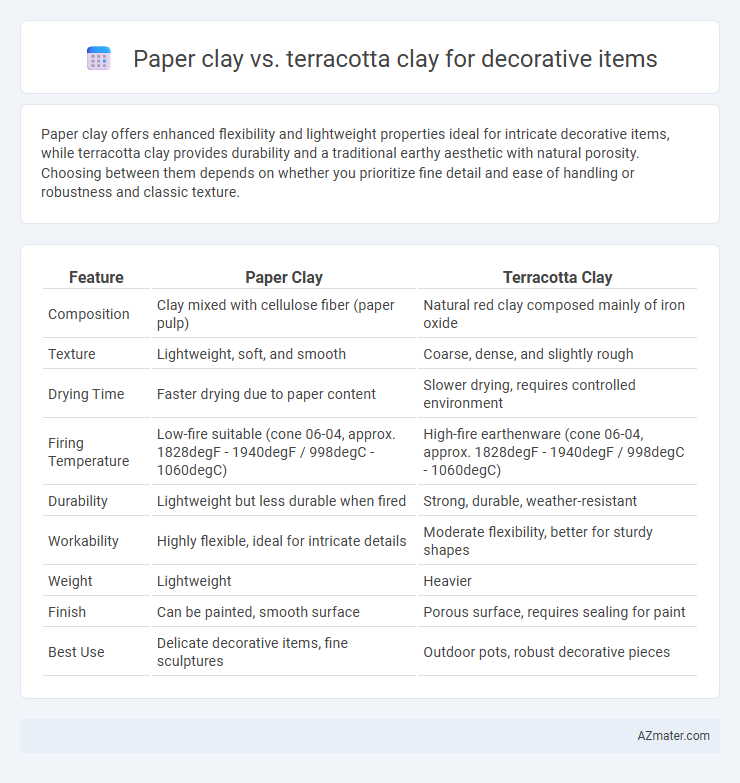Paper clay offers enhanced flexibility and lightweight properties ideal for intricate decorative items, while terracotta clay provides durability and a traditional earthy aesthetic with natural porosity. Choosing between them depends on whether you prioritize fine detail and ease of handling or robustness and classic texture.
Table of Comparison
| Feature | Paper Clay | Terracotta Clay |
|---|---|---|
| Composition | Clay mixed with cellulose fiber (paper pulp) | Natural red clay composed mainly of iron oxide |
| Texture | Lightweight, soft, and smooth | Coarse, dense, and slightly rough |
| Drying Time | Faster drying due to paper content | Slower drying, requires controlled environment |
| Firing Temperature | Low-fire suitable (cone 06-04, approx. 1828degF - 1940degF / 998degC - 1060degC) | High-fire earthenware (cone 06-04, approx. 1828degF - 1940degF / 998degC - 1060degC) |
| Durability | Lightweight but less durable when fired | Strong, durable, weather-resistant |
| Workability | Highly flexible, ideal for intricate details | Moderate flexibility, better for sturdy shapes |
| Weight | Lightweight | Heavier |
| Finish | Can be painted, smooth surface | Porous surface, requires sealing for paint |
| Best Use | Delicate decorative items, fine sculptures | Outdoor pots, robust decorative pieces |
Introduction to Paper Clay vs Terracotta Clay
Paper clay consists of natural clay mixed with cellulose fibers, enhancing its strength, flexibility, and workability compared to traditional terracotta clay. Terracotta clay is a porous, red-brown earthenware known for its durability and rustic aesthetic, commonly used in pottery and decorative items. The inclusion of paper fibers in paper clay reduces cracking during drying and firing, making it ideal for intricate decorative pieces and repairs where fine detail is necessary.
What is Paper Clay?
Paper clay is a lightweight, porous clay mixed with cellulose fibers, enhancing its flexibility and strength during drying and firing processes. Compared to terracotta clay, paper clay allows for finer detailing and easier repair of cracks, making it ideal for delicate decorative items. Its ability to adhere to dry pieces while maintaining a smooth surface distinguishes it from the traditional, earthy terracotta clay often used for robust, outdoor sculptures.
What is Terracotta Clay?
Terracotta clay is a natural, porous clay rich in iron oxide, giving it a distinctive reddish-brown color and making it ideal for decorative pottery and sculptural items. It fires at a lower temperature, around 1000degC to 1150degC, resulting in a durable, yet slightly porous finish that can be left unglazed for a rustic appearance. Unlike paper clay, terracotta lacks added fibers, offering a traditional clay texture and strength preferred for classic garden pots and ornamental designs.
Key Material Differences
Paper clay contains a significant amount of cellulose fiber mixed with clay, making it lightweight, more flexible, and easier to sculpt intricate details compared to terracotta clay. Terracotta clay is composed primarily of natural earthen clay rich in iron oxide, which gives it its characteristic reddish-brown color and results in a porous, durable finish after firing. The higher shrinkage rate and lower plasticity of terracotta make it less forgiving during drying and firing, whereas paper clay's fiber content reduces cracking and breakage, ideal for delicate decorative items.
Workability and Sculpting Ease
Paper clay offers superior workability and sculpting ease compared to terracotta clay due to its lightweight, flexible nature and added cellulose fibers, which reduce cracking during drying and firing. Terracotta clay is denser and less pliable, making intricate detailing more challenging but providing a traditional, rustic finish favored for certain decorative styles. Artists seeking fine sculpting detail and ease of manipulation often prefer paper clay for its smooth texture and forgiving drying process.
Strength and Durability for Decorative Items
Terracotta clay offers superior strength and durability compared to paper clay, making it ideal for long-lasting decorative items exposed to outdoor elements. Paper clay, while lightweight and easy to mold, tends to be more fragile and less resistant to moisture and impact. For decorative items requiring robust structural integrity and weather resistance, terracotta clay remains the preferred choice.
Firing and Drying Requirements
Paper clay requires slower drying to prevent cracking due to its fiber content, which enhances its flexibility and strength during both drying and firing. Terracotta clay demands thorough drying to avoid explosions in the kiln, as its porous composition retains moisture more readily, impacting the firing process at typically lower temperatures around 1000degC to 1100degC. Paper clay allows for more extended drying times and higher firing temperatures, often reaching stoneware levels around 1200degC, resulting in more durable decorative items.
Finishing and Surface Effects
Paper clay offers a smoother, more refined surface finish compared to terracotta clay, making it ideal for intricate decorative items requiring delicate details. Its lightweight and flexible nature enables easier sanding and carving after drying, allowing for superior surface effects and fine texture. Terracotta clay, with its coarse texture and earthy tone, provides a rustic and natural finish suited for traditional or antique-style decorative pieces, often highlighting warm, reddish hues and organic imperfections.
Cost and Availability Comparison
Paper clay typically costs more than terracotta clay due to added materials like paper fibers, but it offers greater workability and reduced drying time. Terracotta clay is widely available and more affordable, making it a popular choice for decorative items that require traditional firing and natural earthy tones. Availability of terracotta is more consistent in local craft stores, while paper clay may require specialized suppliers or online purchases, impacting overall cost and accessibility.
Best Uses for Decorative Projects
Paper clay excels in fine detail work and lightweight decorative items due to its flexibility and ability to be joined when dry, making it ideal for intricate sculptures and wall art. Terracotta clay offers durability and a natural earthy color, perfect for rustic, outdoor decor and functional pottery with a traditional aesthetic. For decorative projects requiring delicate designs and easy manipulation, paper clay is best, while terracotta suits robust, weather-resistant items.

Infographic: Paper clay vs Terracotta clay for Decorative item
 azmater.com
azmater.com